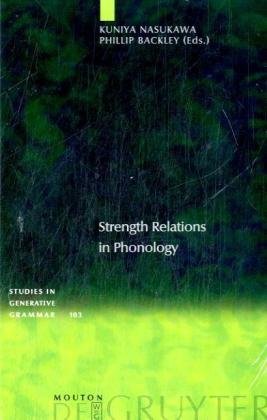

Most ebook files are in PDF format, so you can easily read them using various software such as Foxit Reader or directly on the Google Chrome browser.
Some ebook files are released by publishers in other formats such as .awz, .mobi, .epub, .fb2, etc. You may need to install specific software to read these formats on mobile/PC, such as Calibre.
Please read the tutorial at this link: https://ebookbell.com/faq
We offer FREE conversion to the popular formats you request; however, this may take some time. Therefore, right after payment, please email us, and we will try to provide the service as quickly as possible.
For some exceptional file formats or broken links (if any), please refrain from opening any disputes. Instead, email us first, and we will try to assist within a maximum of 6 hours.
EbookBell Team

5.0
48 reviews

ISBN 10: 3110218585
ISBN 13: 9783110218589
Author: Kuniya Nasukawa, Phillip Backley
This collection of papers focuses on the general theme of phonological strength, bringing together current work being undertaken in a variety of leading theoretical frameworks. Its aim is to show how referring directly to strength relations can facilitate explanation in different parts of the phonological grammar.
The papers introduce illuminating data from a wide range of languages including English, Dutch, German, Greek, Japanese, Bambara, Yuhup, Nivkh, Sesotho and other Bantu systems, demonstrating how strength differences are central to the analysis of phonological patterning not only in well-documented cases of segmental asymmetry but also in other areas of description including language acquisition, pitch accent patterns and tonal phenomena. All of the contributors agree on the need for a phonological (as opposed to a phonetic) approach to the question of strength differences, and show how a strength-based analysis may proceed in various theoretical models including Dependency Phonology, Government Phonology, Strict CV Phonology and Optimality Theory.
Many of the papers develop a structural account of their data, in which strength relations are understood to reflect asymmetric licensing relations holding between units in representations. The volume provides a snapshot of current thinking on the question of strength in phonology. The range of language data and theoretical contexts it explores give a clear indication that phonological strength acts as a common thread to unite a range of apparently unrelated patterns and processes.
Introduction
Why final obstruent devoicing is weakening
Headship as melodic strength
Transparency in nasal harmony and the limits of reductionism
Developmental shifts in phonological strength relations
Strength relations and first language acquisition
Modelling initial weakenings
The syllabic affiliation of English postvocalic consonants
Defining initial strength in clusterless languages in Strict CV
A syllable-based OT approach
The phonological structure of the Limburg tonal accents
Projection of licensing potency from a phonological expression
Backmatter
strength relations in phonology
strengthening phonology examples
what is phonology in psychology
relationship between phonology and orthography
pronouncing strength as /strɛŋkθ/ is an example of
Tags: Kuniya Nasukawa, Phillip Backley, Strength, Relations, Phonology